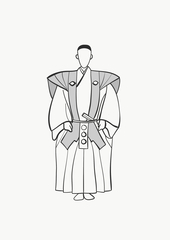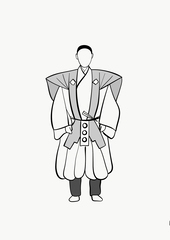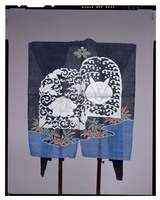「Kataginu」の版間の差分
編集の要約なし |
(相違点なし)
|
2025年4月30日 (水) 09:00時点における最新版
かたぎぬ 肩衣
A kataginu is a sleeveless hemp upper garment worn by servants and commoners in kyōgen. Pattern-dyed, the kataginu is generally combined with short pleated trousers (hakama) or with pantaloons bound at the calf (kukuribakama).
Noh Kyogen
Roles and draping
The kataginu is emblematic of kyōgen costumes and worn for a broad spectrum of roles. The servants Tarō-kaja and Jirō-kaja wear kataginu over hakama, as does the ai-kyōgen. Active characters combine the kataginu with kukuribakama, while messengers might slip off the right sleeve.


Tailoring and Textile Features
Basically the same as the top of a kamishimo matched suit, the unlined, plain weave, hemp vest has two back panels that are about hip length and stitched together with a center seam. The front panels are pleated so they form wing shoulders and converge into broad bands that run down each chest and are tucked into the trouser belt. The rectangular back of the kataginu is decorated with stenciled or hand-drawn paste-resist designs or painted designs.
Typical designs and motifs
Old kataginu generally have small repeat patterns of white on a solid blue or green or grey ground, while later Edo period and more modern kataginu tend to have large pictorial designs, often homely in content: large insects, oversize flowers, birds soaring over reeds in water, or cherry blossoms falling into waves. Kataginu have dandelion crests at the center back and at chest level on the front pleated panels.

Kataginu with rabbits among waves, peony scrolls, and seaside bamboo grass on a black and light blue divided ground. 19th century. Tokyo National Museum.
http://webarchives.tnm.jp/imgsearch/show/C0058481
Contributor
Monica Bethe